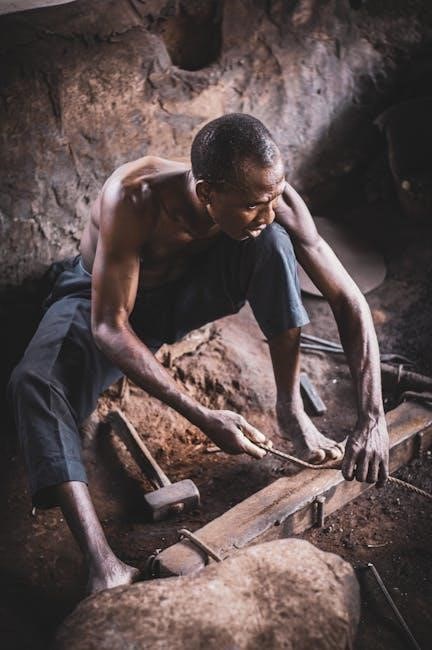Blacksmithing is a crafting profession that involves shaping metal to create weapons, armor, and tools. Historically, it has been a cornerstone in RPGs, allowing players to craft essential gear. This guide explores its fundamentals, from basic techniques to advanced strategies, helping you master the art of shaping metal into powerful equipment for your journey.
1.1 What is Blacksmithing?
Blacksmithing is a crafting profession that involves shaping and strengthening metal to create weapons, armor, tools, and other equipment. In RPGs, it allows players to craft gear tailored to their character’s needs, enhancing gameplay. The process typically involves gathering materials, learning recipes, and using specific tools like anvils and forges. As a key profession, blacksmithing enables players to produce items that improve their character’s performance, making it a valuable skill for progression. By mastering blacksmithing, players can craft powerful equipment, customize their gear, and gain a competitive edge in the game world. This guide will explore the intricacies of blacksmithing, helping you unlock its full potential.
1.2 Importance of Blacksmithing in Gaming
Blacksmithing holds significant importance in gaming, particularly in RPGs, as it provides players with a means to craft essential items. By creating weapons, armor, and tools, players can enhance their characters’ abilities, making progression more efficient. This profession allows for customization, enabling players to craft gear that suits their specific playstyle. Additionally, blacksmithing can be a lucrative skill, as crafted items are often in high demand among other players, offering opportunities for profit. The ability to craft rare and powerful equipment also grants a competitive edge in both PvE and PvP environments, making blacksmithing a valuable and sought-after skill in many games. Its impact on gameplay and economy underscores its importance in the gaming world.
1.3 Brief History of Blacksmithing in RPGs
Blacksmithing has been a cornerstone in RPGs, offering players the ability to craft vital equipment. In early games like Classic WoW, players could learn blacksmithing from trainers in major cities, progressing through ranks like Apprentice and Master. The profession evolved, with games introducing advanced crafting systems, allowing for epic gear and rare items. Blacksmithing became integral to character progression, enabling players to forge weapons and armor tailored to their needs. Its historical significance lies in its adaptability, from basic crafting to complex, high-demand items. This evolution has cemented blacksmithing as a staple in RPGs, shaping both character power and in-game economies for decades.

Getting Started with Blacksmithing
Getting started with blacksmithing involves learning the basics of crafting weapons and armor. Find a trainer in major cities to learn the trade. Equip essential tools like anvils and hammers to begin crafting. Choose a specialization to focus on either weapons or armor. Gather materials from vendors or loot to start crafting basic items. Practice regularly to improve your skills and unlock new recipes as you progress. This foundation will help you master the craft and create powerful gear for yourself or others.
2.1 Choosing the Right Specialization
Choosing the right specialization is crucial for effective blacksmithing. Most games offer two main paths: weaponsmithing and armorsmithing. Weaponsmithing focuses on crafting weapons like swords, axes, and maces, ideal for players who enjoy dealing damage. Armorsmithing specializes in creating armor pieces, such as helmets, chestplates, and boots, perfect for tanks or players who prioritize survivability. Some games also offer sub-specializations, like focusing on mail or plate armor. Consider your playstyle, class, and in-game goals when selecting a specialization. Specializing early allows you to maximize efficiency and resources, ensuring you craft gear that aligns with your character’s needs or market demand. This choice will significantly impact your progression and crafting experience.
2.2 Finding a Blacksmith Trainer
Finding a blacksmith trainer is a essential step in your journey. These trainers are typically located in major cities or near crafting hubs. In many RPGs, trainers are marked on the map or can be found by asking guards for directions. Ensure your character meets the level or reputation requirements to unlock training. Some games also allow learning recipes from dropped items or purchased scrolls. Always verify the trainer’s specialization matches your chosen path. Training regularly is vital to unlock new recipes and improve efficiency. Keep enough gold on hand, as training can be costly. Don’t hesitate to explore multiple trainers for the best options, as some may offer exclusive recipes or discounts.

2.3 Essential Tools for Blacksmithing
To begin blacksmithing, you’ll need a few essential tools. A sturdy anvil is your workspace for shaping metals, while a forge or hearth provides the heat needed to melt and craft items. A reliable hammer is crucial for shaping metal, and tongs help handle hot materials safely. Additional tools like quenching oil and whetstones are useful for cooling and sharpening items. Some games may require secondary tools like metal ingots or alloy recipes to craft advanced gear. Always ensure your tools are in good condition and upgraded as you progress. Having the right equipment will significantly improve your crafting efficiency and output quality.

Leveling Up: Early Stages
Mastering the basics is key to early progression. Focus on crafting simple items to build skill and gather materials efficiently, laying a strong foundation for advanced techniques.
3.1 Level 1-30: Basic Crafting and Materials
At the earliest stages of blacksmithing, focus on crafting basic items like nails, simple weapons, and armor. These recipes require minimal materials and provide consistent XP. Start by gathering copper ore and iron ore, which are abundant in early zones. Use these to craft copper bars and iron bars, the foundation of most early recipes. Always keep a stack of wood or coal on hand for fueling the forge. As you progress, experiment with combining materials to create slightly more complex items. Regularly check vendors or crafting suppliers for additional resources. Consistency is key—craft as often as possible to build your skill and prepare for higher-level recipes.
3.2 Level 30-50: Intermediate Recipes and Techniques
As you reach level 30, focus on transitioning to intermediate recipes that require more complex materials. Start crafting items like steel swords, reinforced armor, and decorative items for both functionality and skill progression. This phase introduces the use of steel bars, which are crafted by combining iron ore with coal. Experiment with enchanting or imbuing basic weapons to add elemental properties, increasing their value. Additionally, learn to deconstruct unwanted items to salvage materials. Prioritize crafting items in high demand, such as weapon repairs or armor kits, to optimize XP gain and resource efficiency.
3.3 Level 50-70: Unlocking Advanced Recipes

Reaching level 50 unlocks advanced blacksmithing recipes, allowing you to craft intricate items like epic weapons and heavy armor pieces. Focus on mastering recipes for adamantite or mithril gear, which are highly sought after by players. This stage introduces complex techniques such as folded steel crafting and gemstone infusion, enhancing both the aesthetic and functional value of your creations. Prioritize crafting items with high demand, such as chestplates and gauntlets, to maximize XP gain. Experiment with enchanting or imbuing to add unique properties to your gear. Optimize material usage by crafting in bulk and focusing on items with high market value.

Mid-Game Leveling Strategies
Focus on crafting high-demand items like epic gear and optimizing material usage to maximize efficiency. Utilize advanced techniques and addons to streamline production and stay competitive.
4.1 Level 70-90: Crafting High-Demand Items
At this stage, focus on crafting high-demand items like epic weapons and armor sets. These are sought after by players progressing through mid-game content. Optimize your recipes to ensure maximum efficiency and minimize material waste. Prioritize crafting gear that aligns with your specialization, such as plate armor for tanks or weapons for DPS classes. Additionally, consider crafting items that complement popular class builds or raid compositions. This not only boosts demand but also increases your profitability. Always keep a stockpile of rare materials for crafting intricate designs. Regularly check the market to identify gaps in supply and adjust your production accordingly. Mastery of these strategies ensures steady progression and prepares you for higher-level crafting challenges.
4.2 Level 90-110: Optimizing Material Usage
During this phase, refining your material usage becomes critical to minimize waste and maximize efficiency. Focus on crafting items that require fewer rare materials but remain in high demand. Implement a system to track and categorize your resources, ensuring you use lower-grade materials for experimental crafting and reserve high-quality materials for final products. Experiment with patterns that yield the best results with minimal scrap. Additionally, consider deconstructing unused or lower-tier items to reclaim valuable resources; By adopting these strategies, you can maintain a steady supply of materials and reduce crafting costs. This approach ensures sustainable progression and prepares you for the demands of higher-level crafting.
4.3 Level 110-130: Crafting Epic Gear
Reaching levels 110-130 in blacksmithing unlocks the ability to craft epic gear, which is highly sought after by players. These items require rare and superior materials, such as enchanted ores and refined metals. Crafting epic gear demands precision, as the failure rate is higher due to the complexity of the recipes. Focus on mastering intricate patterns and techniques, such as folding and tempering, to ensure success. Prioritize crafting items with high demand, like legendary weapons or armor sets, to maximize your progress. Experiment with rare materials to discover unique properties and enhance your creations. This phase is crucial for building a reputation as a skilled blacksmith and preparing for the challenges ahead.

Late-Game Mastery
Mastering blacksmithing at higher levels involves refining techniques, experimenting with rare materials, and crafting exceptional gear. Focus on efficiency, innovation, and perfecting intricate designs to excel.
5.1 Level 130-150: Specialized Crafting
At levels 130-150, blacksmithing transitions into specialized crafting, focusing on intricate designs and rare materials. Craftsmen can create masterwork weapons and armor with unique properties, such as enhanced elemental resistance or increased agility. This phase demands precision and mastery of advanced techniques, as even minor errors can ruin high-quality items. Recipes become more complex, requiring rare ores like Starsteel or Voidstone. Crafting during this stage is ideal for equipping high-level characters or trading for gold. Specialized crafting also unlocks the ability to create class-specific gear, catering to diverse playstyles. This period is critical for building a reputation as a skilled blacksmith and preparing for the challenges of late-game content.
5.2 Level 150-170: Crafting Rare and Exotic Items
Reaching levels 150-170 in blacksmithing unlocks the ability to craft rare and exotic items, which are highly sought after by players. These items often require rare materials, such as enchanted metals or mythical ores, and involve intricate crafting patterns. Crafting these items not only enhances your reputation as a master blacksmith but also provides significant in-game advantages. Rare gear often boasts unique properties, such as increased damage output or enhanced survivability, making it highly valuable to top-tier players. This stage also introduces limited-edition recipes, which can only be crafted during specific in-game events or seasons. Mastering these recipes can set your blacksmithing skills apart and grant access to exclusive rewards.
5.3 Level 170-200: Maximizing Efficiency
At levels 170-200, blacksmithing focuses on maximizing efficiency to craft high-tier items with minimal waste. Advanced techniques, such as optimizing material usage and streamlining production processes, become crucial; Players can utilize addons or in-game tools to track material costs and crafting success rates. Experimenting with recipes to reduce failure chances ensures resource conservation. Additionally, mastering the art of deconstructing epic gear to reclaim rare materials enhances efficiency. This stage also emphasizes consistent practice and adapting to market demands to craft items that are both powerful and profitable. By refining these skills, blacksmiths can achieve mastery, crafting legendary items with precision and speed.

Advanced Blacksmithing Techniques
Advanced blacksmithing techniques involve mastering high-level crafting, optimizing material usage, and utilizing tools like addons for efficiency. These methods elevate your crafting to expert levels.

6.1 Using Addons for Optimal Crafting
Addons can significantly enhance your blacksmithing experience by streamlining crafting processes. Tools like TradeSkillMaster or Auctionator help manage recipes, track materials, and automate repetitive tasks. These addons provide real-time market data, enabling you to craft items in high demand, maximizing profits. They also offer customizable crafting lists, allowing you to prioritize recipes based on material availability and profitability. Additionally, addons can highlight optimal crafting sequences, reducing material waste and increasing efficiency. By integrating these tools, you can refine your crafting strategy, save time, and focus on creating high-quality gear. They are especially useful for advanced players aiming to optimize their blacksmithing workflow and stay competitive in the in-game economy.

6.2 Crafting for Profit: Selling Your Gear
Crafting for profit is a key aspect of blacksmithing, allowing you to generate in-game gold. To succeed, focus on creating items in high demand, such as weapons, armor, and gear upgrades. Use market analysis tools like Auctionator or TradeSkillMaster to identify profitable recipes and set competitive prices. Crafting epic or rare items can yield higher returns, especially during peak raiding or PvP seasons. Consider crafting in bulk during off-peak hours to avoid market saturation. Additionally, specialize in niche markets, such as crafting gear for specific classes or professions, to corner a segment of the market. Consistent production and smart pricing will help you maximize profits and establish yourself as a reliable seller.
6.3 Mastering Deconstruction for Materials
Deconstruction is a vital skill in blacksmithing, allowing you to break down unwanted gear into valuable materials. This process is essential for reclaiming rare components, such as ores, ingots, and enchanting materials. To master deconstruction, focus on dismantling lower-level items, as they often yield higher-quality materials. Prioritize breaking down gear with unique properties or enchantments, as these can provide rare resources. Keep an organized inventory to efficiently manage the materials you recover. Regularly deconstructing items ensures a steady supply of resources for crafting high-tier equipment. Additionally, materials from deconstruction can be sold to other players or used to optimize your own gear. This technique is crucial for both leveling up and maintaining a competitive edge in the game.
Congratulations on completing the blacksmithing guide! Mastery requires dedication and practice. From basic crafting to advanced techniques, you’ve unlocked the secrets of this ancient craft. Continuous improvement is key to success. Keep refining your skills, and enjoy the rewards of your hard work in the endgame!
7.1 Final Tips for Success in Blacksmithing
To excel in blacksmithing, stay organized and manage your materials efficiently. Experiment with recipes to discover unique items and enhance your creations. Join a guild or community for shared knowledge and resources; Focus on quality over quantity to craft gear that stands out. Keep an eye on market trends to maximize profits when selling. Most importantly, never stop learning—continuous improvement is the key to mastery. By following these tips, you’ll become a renowned blacksmith, crafting legendary items and shaping the in-game economy; Remember, patience and dedication will always yield the best results in your blacksmithing journey.
7.2 The Future of Blacksmithing in Gaming
The future of blacksmithing in gaming looks promising, with advancements in technology offering new opportunities. Expansions and updates to popular MMORPGs are likely to introduce fresh recipes, materials, and crafting mechanics. Sandbox games may incorporate more complex crafting systems, allowing players to create intricate items. The rise of cross-platform play could also enhance collaborative crafting experiences. Additionally, virtual reality (VR) and augmented reality (AR) could revolutionize blacksmithing by making it more immersive. As games evolve, blacksmithing will remain a vital skill, offering players both utility and creativity. This enduring appeal ensures that blacksmithing will continue to be a beloved feature in gaming for years to come.

Leave a Reply
You must be logged in to post a comment.